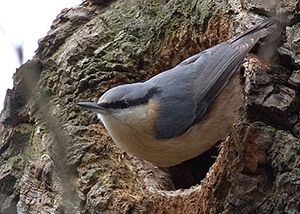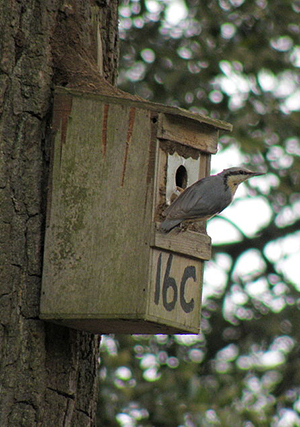Nuthatches and Bluebirds
Nuthatches and Bluebirds
By Environmental Management System
August, 2014

Photo courtesy of Lawrie Phipps
Facing significantly declining bluebird populations due to habitat loss, bird watchers, naturalists, and other concerned citizens have rallied to the bluebirds’ defense. Over the last several decades, thousands of bluebird nesting boxes have been erected across the southeast, and the bluebird population is likely at an all-time high. However, the success of the bluebird has had a negative effect on another threatened species in the same area.
Brown-headed Nuthatches
As the population of bluebirds has increased, nuthatches have had a harder time finding safe places to nest. Brown-headed nuthatches population has dropped by as much as 30% in the last decade. The loss of mature pine woodlands in the greater Triangle area has led to reduced food sources (pine seeds, forest insects) and dead trees for nuthatches to live in across the region.

Photo courtesy of Gavin Hill
With housing options for nuthatches decreasing, they will seek out blue bird nesting boxes, even though it may not be located in dense woodland. Bluebirds will chase, harass, and bully nuthatches, which are about one third the size of bluebirds. If housing is in particularly high demand, a bluebird will force the nuthatch from a nest box and even prevent occupation of a vacant box by nuthatches.
One Size Doesn’t Fit
All Nuthatches need nesting boxes with openings smaller than that of blue birds. An unused blue bird house can be retrofitted (blue bird proofed) with a smaller diameter opening (one inch rather than one and a half inches) for the nuthatch. These retrofitted boxes should be placed in pine trees and away from bluebird nest boxes.
Nuthatch nest building begins each year in December, with birds laying five to seven brown and white speckled eggs each between March and May. The young then stay in the nest until early June. Nuthatches are family oriented birds, and birds born in the previous season will stay around to help with the next set of young. Nuthatches are also able to use pieces of bark as tools to expose insect larvae and walk head first down pine trees.
NIEHS Environmental Awareness Advisory Committee will be conducting a bird survey this fall to evaluate the existing nesting boxes and habitat options on the NIEHS campus. Empty bluebird nesting boxes will be relocated or resized to better attract nuthatches. Available nesting boxes may also be placed on metal poles, instead of attached to a pine tree, to deter snakes and other predators. If you’re listening for bird calls on campus, the nuthatch makes a call that sounds like squeaky rubber duck toy.
For more information, the News and Observer recently published an article about the population growth of the nuthatch and bluebird.



